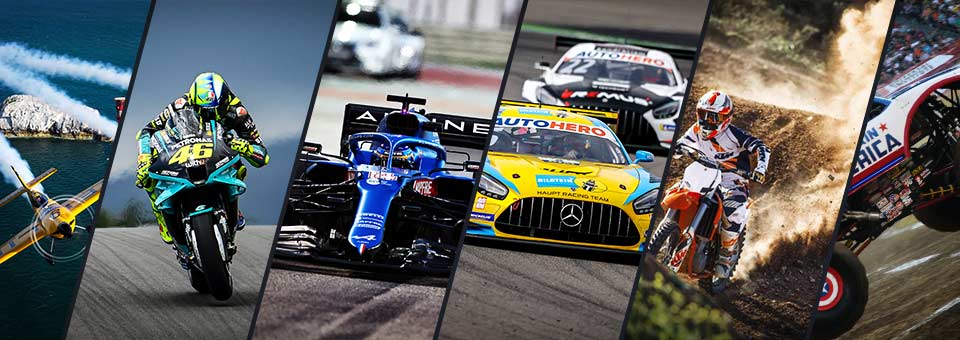Introduction: The Thrill of Speed and Competition
Racing sports have long captivated audiences around the world with their adrenaline-pumping action and fierce competition. From Formula 1 to MotoGP, the world of racing offers a diverse array of disciplines, each with its own unique challenges and appeal. In this comprehensive exploration, we’ll dive into the exciting world of racing sports, shedding light on the history, evolution, and current state of this thrilling global phenomenon.

A Brief History of Racing Sports
Racing sports have roots that stretch back centuries, with chariot races in ancient Rome and horse racing in medieval Europe serving as early examples of organized racing competitions. Over time, racing evolved to include motorized vehicles, with the invention of the automobile in the late 19th century paving the way for modern racing as we know it today.
Exploring Different Disciplines
1. Formula 1 (F1)
Formula 1, often referred to as the pinnacle of motorsport, features the world’s fastest cars and most skilled drivers competing on circuits around the globe. With cutting-edge technology, high-speed racing, and intense rivalries, F1 attracts millions of fans worldwide and boasts a rich history dating back to its inaugural season in 1950.
2. MotoGP
MotoGP is the premier motorcycle racing championship, showcasing the speed, skill, and bravery of riders on two-wheeled machines. With races held on a variety of circuits, from tight street circuits to fast-flowing tracks, MotoGP offers heart-stopping action and close competition, making it a favorite among motorcycle enthusiasts.
3. NASCAR
NASCAR, or the National Association for Stock Car Auto Racing, is synonymous with American racing culture, featuring high-speed oval track racing with stock cars. Known for its close-quarters racing, dramatic finishes, and passionate fan base, NASCAR events attract millions of spectators and television viewers each year, cementing its status as one of the most popular racing series in the United States.
4. Endurance Racing
Endurance racing tests the durability and stamina of both drivers and machines, with events such as the 24 Hours of Le Mans and the Rolex 24 at Daytona challenging participants to push their limits over extended periods of time. Endurance races require strategic planning, teamwork, and exceptional driving skill, making them a true test of endurance and skill.
The Evolution of Racing Technology
1. Aerodynamics
Aerodynamics play a crucial role in racing performance, with engineers constantly striving to optimize airflow and reduce drag to maximize speed and stability. Advanced aerodynamic features such as wings, diffusers, and air scoops help racing vehicles slice through the air with minimal resistance, enhancing performance on the track.
2. Engine Technology
Engine technology has undergone significant advancements in racing, with manufacturers pushing the boundaries of power, efficiency, and reliability. From turbocharged engines to hybrid powertrains, racing engines incorporate cutting-edge technology to deliver maximum performance while adhering to strict regulations and sustainability goals.
3. Safety Innovations
Safety innovations have transformed racing sports, reducing the risk of injury and improving driver protection in the event of accidents. Features such as roll cages, impact-absorbing barriers, and advanced helmet designs enhance driver safety and contribute to the overall well-being of participants in racing events.
The Global Appeal of Racing Sports
1. Cultural Significance
Racing sports hold cultural significance in countries around the world, with events such as the Monaco Grand Prix, the Indianapolis 500, and the Isle of Man TT becoming iconic symbols of national pride and heritage. Racing traditions, rituals, and celebrations are deeply ingrained in the fabric of communities, fostering a sense of belonging and camaraderie among fans and participants alike.
2. Economic Impact
Racing sports have a significant economic impact, generating revenue from ticket sales, sponsorships, merchandise, and tourism. Major racing events attract visitors from far and wide, stimulating local economies and supporting jobs in industries such as hospitality, transportation, and event management.
3. Global Reach
With television broadcasts, streaming services, and digital media platforms, racing sports have a global reach, reaching audiences in countries across continents. Live broadcasts, highlight reels, and social media engagement allow fans to connect with their favorite drivers and teams, regardless of geographical location, fostering a sense of community and shared passion for the sport.
Conclusion: The Thrilling World of Racing Awaits
As we delve into the world of racing sports, we uncover a dynamic and exhilarating landscape filled with speed, skill, and excitement. From the historic circuits of Formula 1 to the high-speed ovals of NASCAR, racing sports offer something for everyone, uniting fans and participants from diverse backgrounds in a shared celebration of speed and competition. As we look to the future, one thing is certain: the thrill of racing will continue to captivate audiences and inspire generations of enthusiasts around the world.